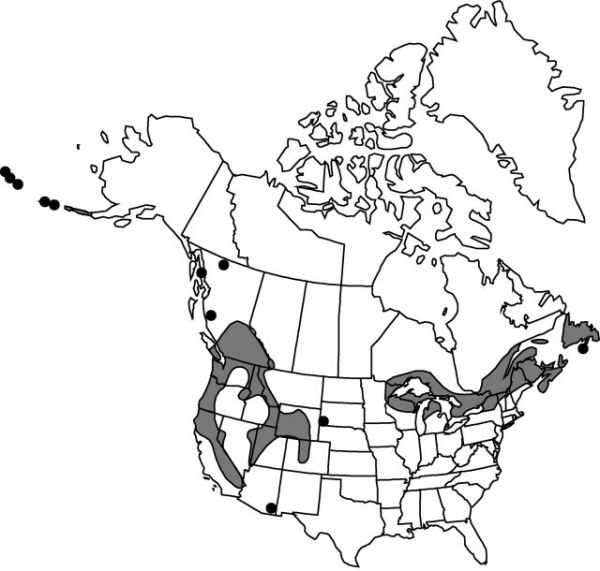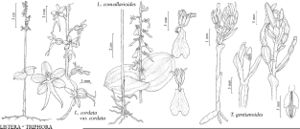Difference between revisions of "Listera convallarioides"
Sketch Bot. S. Carolina 2: 494. 1823.
RevisionBot (talk | contribs) m (Bot: Adding category Revised Since Print) |
RevisionBot (talk | contribs) m (Bot: Adding category Revised Since Print) |
||
| (11 intermediate revisions by 3 users not shown) | |||
| Line 8: | Line 8: | ||
}} | }} | ||
|common_names=Broad-leaved twayblade | |common_names=Broad-leaved twayblade | ||
| − | |basionyms={{Treatment/ID/ | + | |special_status={{Treatment/ID/Special_status |
| + | |code=F | ||
| + | |label=Illustrated | ||
| + | }}{{Treatment/ID/Special_status | ||
| + | |code=E | ||
| + | |label=Endemic | ||
| + | }} | ||
| + | |basionyms={{Treatment/ID/Basionym | ||
|name=Epipactis convallarioides | |name=Epipactis convallarioides | ||
|authority=Swartz | |authority=Swartz | ||
| + | |rank=species | ||
| + | |publication_title=Kongl. Vetensk. Acad. Nya Handl. | ||
| + | |publication_place=21: 232. 1800 | ||
}} | }} | ||
|synonyms={{Treatment/ID/Synonym | |synonyms={{Treatment/ID/Synonym | ||
|name=Bifolium convallarioides | |name=Bifolium convallarioides | ||
|authority=(Swartz) Nieuwland | |authority=(Swartz) Nieuwland | ||
| − | }}{{Treatment/ID/Synonym | + | |rank=species |
| + | }} {{Treatment/ID/Synonym | ||
|name=Diphryllum convallarioides | |name=Diphryllum convallarioides | ||
|authority=(Swartz) Kuntze | |authority=(Swartz) Kuntze | ||
| − | }}{{Treatment/ID/Synonym | + | |rank=species |
| + | }} {{Treatment/ID/Synonym | ||
|name=Listera eschscholziana | |name=Listera eschscholziana | ||
|authority=Chamisso | |authority=Chamisso | ||
| − | }}{{Treatment/ID/Synonym | + | |rank=species |
| + | }} {{Treatment/ID/Synonym | ||
|name=Ophrys convallarioides | |name=Ophrys convallarioides | ||
|authority=(Swartz) W. Wight | |authority=(Swartz) W. Wight | ||
| + | |rank=species | ||
}} | }} | ||
|hierarchy=Orchidaceae;Orchidaceae subfam. Epidendroideae;Orchidaceae tribe Neottieae;Orchidaceae (tribe Neottieae) subtribe Limodorinae;Listera;Listera convallarioides | |hierarchy=Orchidaceae;Orchidaceae subfam. Epidendroideae;Orchidaceae tribe Neottieae;Orchidaceae (tribe Neottieae) subtribe Limodorinae;Listera;Listera convallarioides | ||
| Line 39: | Line 53: | ||
|elevation=100–2600 m | |elevation=100–2600 m | ||
|distribution=St. Pierre and Miquelon;Alta.;B.C.;N.B.;Nfld. and Labr. (Nfld.);N.S.;Ont.;P.E.I.;Que.;Alaska (including Aleutian Islands);Ariz.;Calif.;Colo.;Idaho;Maine;Mich.;Minn.;Mont.;Nev.;N.H.;N.Y.;Oreg.;S.Dak.;Utah;Vt.;Wash.;Wis.;Wyo. | |distribution=St. Pierre and Miquelon;Alta.;B.C.;N.B.;Nfld. and Labr. (Nfld.);N.S.;Ont.;P.E.I.;Que.;Alaska (including Aleutian Islands);Ariz.;Calif.;Colo.;Idaho;Maine;Mich.;Minn.;Mont.;Nev.;N.H.;N.Y.;Oreg.;S.Dak.;Utah;Vt.;Wash.;Wis.;Wyo. | ||
| − | |discussion=<p>Listera convallarioides has a relatively large flower compared to most of the other listeras. It crosses with L. auriculata to produce a natural hybrid L. ×veltmanii Case, which is discussed under 3. L. auriculata.</p> | + | |discussion=<p><i>Listera convallarioides</i> has a relatively large flower compared to most of the other listeras. It crosses with <i>L. auriculata</i> to produce a natural hybrid L. ×veltmanii Case, which is discussed under 3. <i>L. auriculata</i>.</p> |
|tables= | |tables= | ||
|references= | |references= | ||
| Line 48: | Line 62: | ||
-->{{#Taxon: | -->{{#Taxon: | ||
name=Listera convallarioides | name=Listera convallarioides | ||
| − | |||
|authority=(Swartz) Nuttall ex Elliott | |authority=(Swartz) Nuttall ex Elliott | ||
|rank=species | |rank=species | ||
| Line 62: | Line 75: | ||
|publication title=Sketch Bot. S. Carolina | |publication title=Sketch Bot. S. Carolina | ||
|publication year=1823 | |publication year=1823 | ||
| − | |special status= | + | |special status=Illustrated;Endemic |
| − | |source xml=https:// | + | |source xml=https://bitbucket.org/aafc-mbb/fna-data-curation/src/2e0870ddd59836b60bcf96646a41e87ea5a5943a/coarse_grained_fna_xml/V26/V26_1204.xml |
|subfamily=Orchidaceae subfam. Epidendroideae | |subfamily=Orchidaceae subfam. Epidendroideae | ||
|tribe=Orchidaceae tribe Neottieae | |tribe=Orchidaceae tribe Neottieae | ||
Latest revision as of 20:36, 6 November 2020
Plants 5–37 cm, somewhat stoloniferous. Stems green, succulent, glabrous. Leaves: blade green, broadly ovate to elliptic, oval or suborbiculate, 2–7 × 1.5–5.8 cm, apex obtuse to rarely acute or apiculate. Inflorescences 5–20-flowered, lax, 20–120 mm; floral bracts semitranslucent, rhombic-ovate to lanceolate, 3–5 × 1–2.5 mm, apex acute to acuminate; peduncle and rachis densely whitish glandular-pubescent. Flowers yellowish green, sometimes faintly tinged with purple; pedicels slender, 2.5–7 mm, glandular-pubescent; ovary glandular-pubescent, becoming glabrate as it matures; sepals and petals reflexed away from column and lip; dorsal sepal ovate-lanceolate to elliptic, 4.5–5 × 1.5–2 mm, apex obtuse to acute; lateral sepals lanceolate, falcate, 4.5–5.5 × 1.5–1.8 mm, apex acute to obtuse; petals linear, falcate, 4–5 × 0.8–1 mm; lip cuneate, apex dilated and shallowly notched, lateral lobes rounded, with small tooth in sinus, tapering to short, slender claw, with indistinct triangular tooth on either side of base above claw, 8–13 × 5–7 mm, margins minutely bristly-ciliate; column arcuate, slender, 2.5–3.5(–4) × 1 mm, apex slightly expanded. Capsules ellipsoid, 8 × 5 mm, essentially glabrous. 2n = 36.
Phenology: Flowering Jun–Sep.
Habitat: Rich humus in open woods to boggy meadows, soil circumneutral or at most only mildly acid, prefers cool soil, widespread across northern part of continent, extending southward only at high elevations
Elevation: 100–2600 m
Distribution

St. Pierre and Miquelon, Alta., B.C., N.B., Nfld. and Labr. (Nfld.), N.S., Ont., P.E.I., Que., Alaska (including Aleutian Islands), Ariz., Calif., Colo., Idaho, Maine, Mich., Minn., Mont., Nev., N.H., N.Y., Oreg., S.Dak., Utah, Vt., Wash., Wis., Wyo.
Discussion
Listera convallarioides has a relatively large flower compared to most of the other listeras. It crosses with L. auriculata to produce a natural hybrid L. ×veltmanii Case, which is discussed under 3. L. auriculata.
Selected References
None.
